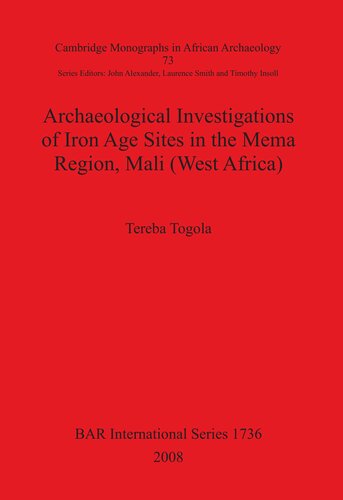

Most ebook files are in PDF format, so you can easily read them using various software such as Foxit Reader or directly on the Google Chrome browser.
Some ebook files are released by publishers in other formats such as .awz, .mobi, .epub, .fb2, etc. You may need to install specific software to read these formats on mobile/PC, such as Calibre.
Please read the tutorial at this link: https://ebookbell.com/faq
We offer FREE conversion to the popular formats you request; however, this may take some time. Therefore, right after payment, please email us, and we will try to provide the service as quickly as possible.
For some exceptional file formats or broken links (if any), please refrain from opening any disputes. Instead, email us first, and we will try to assist within a maximum of 6 hours.
EbookBell Team

5.0
98 reviewsThe region traditionally known as the Méma is a plain of deep alluvial deposits that lies west of the current seasonally flooded Inland Delta of the Niger River and southwest of the Lakes Region. The Méma is also sometimes referred to in the literature as the 'Dead Delta', a name that evokes the presence of a dense network of dry watercourses. This indicates that the Méma once formed a floodplain of pseudo-deltaic hydrology similar to that of the current active floodplain to the southeast. Today, the Méma lies within the sahelian zone and is very dry. The spotty distribution of modern permanent settlement in the Méma contrasts sharply with the situation during the last millennium. The fieldwork presented in this volume has identified numerous Iron Age (IA) habitation mounds. This thriving human settlement, clearly associated with a period of climatic amelioration, extends back in time to the Late Stone Age (LSA). Due to the dearth of information on both the history and archaeology of Méma, the Méma archaeological research program was designed as an exploratory inquiry. The primary objective of the archaeological research program executed from December 1989 to June 1990 was to collect basic data that will permit a preliminary analysis of settlement pattern and radiocarbon and ceramic chronology as well as a careful description of the material culture of the Méma during the Iron Age (IA). Research comprised two components: a) a regional site survey and b) the excavations at the IA site complex of Akumbu. These two components had the broad common goal of collecting basic information from which future research questions and research strategies could be derived.